|
|
|
|
|
Former Graduate Students |
|
 |
Maryam Nouri Aiin Postdoctoral Fellow University of Vermont e-mail Maryam |
|
Maryam received her MS degree in her native Iran, and then came to the University of Vermont to complete the Ph.D. in the laboratory of Dr. Josef Gorres in the Department of Plant and Soil Science. For her MS project, Maryam studied natural soil fungi and their role in as pathogens of an important agricultural pest insect, a stink bug.
For her Ph.D. project, and now her full menu of studies she has worked with the invasive Asian "jumping worms" that are causing serious problems in forests and gardens across the United States. Several species of these earthworms can reach very high densities in forest soils and essentially eliminate the natural understory. The jumping worms are very difficulty to identify, and impossible as eggs, hatchlings, and juveniles. Maryam has studied the ecology, distribution, and genetics of the earthworms, and now has developed a rapid molecular method for identifying them to species (even as eggs!), and has used the population genetics of the worms to understand their origin (Japan), genetic variation among sites, and reproductive biology. The goal of these studies is to control the spread of the jumping worms, so Maryam has developed methods to keep them in the laboratory, even through their life cycle, and is testing various biological control methods, such as fungi. These studies have been appearing in a variety of top journals (some are listed in the publications section of the web site). The threat of the earthworms, as well as their various common names of "jumping worms", "snake worms" (both because of their very active behavior, and "spitting worms" (you don't want to know!), and their often very high densities in compost piles and even gardens, have led to lots of interest by the press. Thus, Maryam has been featured in a variety of sites, and even appeared in a nice color photograph in a story in the New York Times (see it here: PDF) Maryam worked in the parasitology lab because we study the parasites of the earthworms, so the connection made sense to help us understand the biology of the worms and how that information would connect to the transmission biology etc. Maryam began her molecular studies in the parasite lab, then established a full molecular lab in the Plant and Soil Science department. When not working on her many projects, Maryam is an avid hiker, and is completely devoted to her pet parrot. She is also active in several graduate student groups on campus. |
|
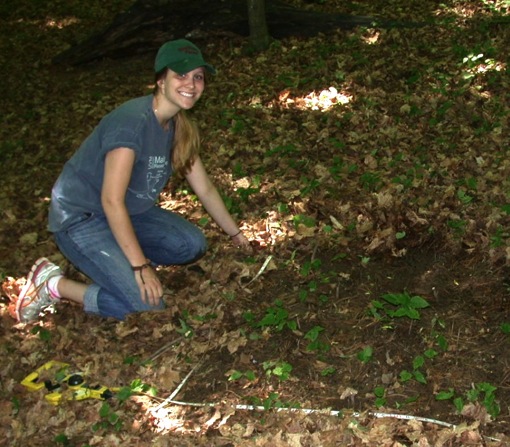 |
Erin Keller Graduate Student Washington State University e-mail Erin |
| Erin completed the Biological Sciences BS major at the university and joined the lab in her Junior year after spending the Fall semester studying in Norway where she also learned the language. She then worked more-or-less full time in the lab on the Monocystis project, and received a summer research fellowship, a very competitive honor, to pursue those studies. Erin was named one of the top five graduating seniors in the Biology Department and was awarded the Phi beta Kappa honor as well. After graduating Erin wanted to finish several projects on Monocystis and the earthworm hosts and so entered our graduate program, working on her MS. Erin discovered a new species of Monocystis in an invasive Asian earthworm Amynthas agrestis, and eventually described this new species in the Journal of Parasitology. She described the life history of this parasite the most detailed for any parasite in the genus. The study required lots of dirty fingernails field work, endless hours on the microscope, and development of new molecular techniques for study of the parasite. Along the way, she found time (how??) to work on the genetics and ecology of the earthworms with the aid of the university's earthworm expert Dr Josef Gorres in the Plant and Soil Sciences Department. She ended with an impressive list of publications now out or in preparation, Erin is now at the Washington State University where she is working on her PhD and studying the viruses of amphibians. Outside of her academic activities Erin is an avid runner and outdoors woman, and also enjoys playing with her cats. | |
 |
Allison Neal Assistant Professor, Norwich University e-mail Allison Visit Allison's website |
Allison entered our graduate program in the fall of 2009 and received her Ph.D. in August 2014. While a graduate student, Allison received three wonderful honors: She was awarded the EAPSI NSF summer fellowship to study with Robert Poulin in New Zealand. Her work with Dr. Poulin centered on how the larvae of a marine trematode worm finds its preferred substrate, and resulted in a publication in Journal of Parasitology. That study required Allison to spend time splashing in the winter seawater of New Zealand's beautiful coast. Soon after learning of the EAPSI award, Allison learned that she was awarded the National Science Foundation Graduate Fellowship for three years, which is perhaps the highest honor for a science graduate student. Then, to complete the NSF trifecta, Allison was awarded the NSF Doctoral Dissertation Improvement Grant to student the ecology of the vector of the lizard malaria parasite Plasmodium mexicanum . The thrust of Allison's dissertation project was to examine the gametocyte sex ratio of Plasmodium mexicanum, particularly the influence of clonal diversity within an infection on the parasite's sex ratio. She used a combination of classical parasitological techniques (hundreds of hours on the microscope), modern molecular methods (genotyping infections using variable genetic markers), experimental manipulations of infection diversity, and modeling. Allison demonstrated that there is genetic diversity for sex ratio when parasites are in single-clone infections, only the second time this has been documented (although the effect may be common). That study was published in Parasitology, Allison's first publication. Allison's second publication, also in Parasitology, examined the relationship between the fecundity (number of gametes produced) for male gametocyte cells and infection sex ratio (the relationship matched expectations of sex ratio theory). A publication, in Evolutionary Ecology used a life history approach to examine interaction of life history traits and the genetic basis for variation in those traits. Allison then turned to modeling, which examined the theory behind sex ratios in malaria parasites. That paper appeared in Evolution. Allison was also an avid teacher as a graduate student, both in the university's biology teaching labs and as a mentor for a small army of undergraduate research students. She was invited three years in a row to give the plenary lecture to the incoming Honors College students, and has represented the department at a grad school fair in Boston. The Biology Department was very lucky that Allison accepted an offer for a Lecturer position for an academic year and she taught large sections of introductory biology and a course on "Science as a Way of Knowing" for nonmajors Allison is now on the faculty of Norwich University where she teaches a variety of courses and always involves her students in research projects on the helminth parasites of local snails as well as continuing with the malaria parasite studies in California. Her research has been funded by the Vermont Genetics Network, a program of the NIH. She also co-directs the Vermont Science Fair, and has been awarded the Vermont Women in Higher Education Peggy R. Williams Award. | |
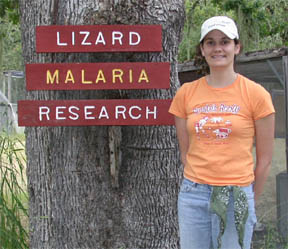 |
Anne Vardo-Zalik, Ph.D. Assistant Professor, Penn State York e-mail Anne |
Anne Vardo-Zalik received her undergraduate degree and MS in Marine Biology from the University of Massachusetts. Early in her education she developed a life-long interest in marine sciences, which led her to the University of Massachusetts programs. For her MS project Anne studied the tapeworms of sharks, and discovered three new species. She then placed her findings into a broad biogeographic picture of shark distribution in the North Atlantic. In 2002 she joined the malaria lab to pursue the Ph.D. Anne first characterized a number of variable micro-satellite markers from the lizard malaria parasite, Plasmodium mexicanum. Using these markers she determined the clonal diversity of the parasite both within and among infections. Anne then determined the role of clonal diversity on the life history, virulence, and transmission biology ofthe parasite. Her studies were conducted both at the Hopland site in California (the photograph shows Anne at her site) and the Vermont laboratory. Anne has published her work in papers in Journal of Parasitology, Molecular Ecology Notes, and Molecular Ecology, International Journal for Parasitology, Parasitological Research, and Ecology. These papers are listed in the "publications" section of this site. Anne found that there is substantial genetic diversity within the P. mexicanum cycling in the lizards at Hopland, even at sites where the parasite has very low prevalence. Because multiclone infections are common at the site, Anne next asked if genetically complex infections display different life history traits and costs to the lizard host. The answers were surprising. She found that single-clone infections all followed a narrow range of rates of increase over time and final parasite density, but mixed-clone infections were much more variable. That is, infections with high parasitemia were the mixed-clone infections, but not all mixed-clone infections followed this virulent pattern. Anne measured the effect of infection on the hosts and found that infection has costs based on a variety of physiological measures, but the most complex infections, with greater than 3 clones, were not virulent and for some measures, these lizards appeared more healthy than lizards not infected with the parasite! Anne then looked at the transmission efficiency of the parasite and found that all clones most often were transmitted to the vector, and relative abundance in the lizard matched relative abundance of clones in the vector. In Anne's final summer as a graduate student, she presented talks at major meetings, the American Society of Parasitologists meetings in Mexico and the Protozoology meetings. She received the outstanding student talk award at both meetings (two for two!). Anne is a dedicated teacher, and mentored a number of undergraduates over her career in our department. These students really shined under Anne's guidance, and are off to fine careers of their own. Anne completed her Ph.D. program at the University in May, 2008 and began a postdoctoral program at the University of California, Irvine with Dr. Guiyun Yan, one of the world's most distinguished malaria researchers. She has traveled to Kenya doing the fieldwork for a study on the genetic diversity and transmission biology of Plasmodium falciparum. In January, 2009 she was funded by the NIH for another three years of postdoctoral studies on human malaria parasites, but was then offered a position as Assistant Professor of Biology at Penn State University, which she could not turn down. She is now Assistant Professor of Biology there, and has been honored with the outstanding teacher of the year award at that university that prizes teaching so highly. Anne teaches a variety of courses at Penn State, including parasitology (of course!) and has involved students in her ongoing research on malaria parasites. Anne continues to be a collaborator with Dr. Allison Neal of Norwich University. |
|
 |
Ellen Martinsen, Ph.D. Research Associate National Zoological Park, Washington Adjunct Assistant Professor, Department of Biology, University of Vermont e-mail Ellen |
Ellen Martinsen has been an avid ornithologist since the age of eight, when she began working with a local wildlife rehabilitation center. Ellen received her BS in Biology from the University of Vermont in 2000. After a few years working as an environmental educator, she returned to the university to pursue the Ph.D. and competed the degree in spring, 2009. While a graduate student she was named the outstanding Teaching Fellow of the year and was honored with the EPA STAR Graduate Fellowship for three years of research on malaria parasites. In August, 2008 Ellen was presented with the prestigious American Ornithologists Union Nellie Johnson Baroody Award for the outstanding student presentation at the joint bird biology meetings in Portland, OR. She then received both a prestigious National Science Foundation Postdoctoral Fellowship and a Smithsonian Postdoctoral Fellowship to work with the avian malaria team at the National Zoo. While there she received a Morris Foundation research grant. She is now a collaborator on a large NSF-funded project on the birds of SE Asia, being the parasite expert on the project. Ellen divides her time between UVM where she is an Adjunct Professor and the National Zoo, and has rejoined the malaria laboratory here to do research and mentor students. Ellen studies the biodiversity of avian malaria parasites of throughout the USA and several international sites (the photo shows her in the Dominican Republic with a friend). She combines study of morphological traits with modern molecular techniques and phylogenetic analysis. Ellen has sampled >4200 birds of over 230 species, and has sequenced hundreds of infections of Plasmodium, Parahemoproteus, Haemoproteus, and Leucocytozoon. The diversity of birds included in Ellen's study is thus very large. The data are analyzed to compare morphological vs. molecular definitions of taxa, to understand host range and possible host switching, and to define the true diversity of the parasites. Ellen also studies the overall evolutionary history of the malaria parasites, using multi-gene approaches. Ellen's publication in Molecular Phylogenetics and Evolution, presents a large phylogeny based on four genes from the parasites' three genomes. The result finds that major clades are associated with vector shifts into different dipteran families. Two other publications have appeared in Parasitology. The first (in collaboration with Ilan Paperna of Hebrew University) focuses on species concepts as applied to malaria parasites. Species identified by morphology are compared using genetic distance and phylogenetic analysis. The second asks if the current subgenera of malaria parasites are monophyletic groups. Another publication, in Journal of Wildlife Diseases presents a survey of the avian malaria parasites in California birds. Ellen's most recent paper showed that Plasmodium, long thought to be absent from any mammal hosts in the Americas, and absent from any deer world-wide, is present in our White-Tailed Deer (WTD). She found two diverse lineages, probably two species, that infect WTD all over the eastern USA. The parasite is common in WTD, with prevalence reaching a quarter of the deer infected at some sites. Ellen was able to date the divergence of the two lineages to about the time the WTD evolved from its ancestor that had traveled to the Americas via the northern landbridge. This paper, in Science Advances caused something of a sensation, appearing in hundreds of news and science websites around the world. A short video on the study appeared on the popular science website IFL Science, and was viewed 1.5 million times over the next 24 hours! Ellen's current research is on the malaria parasites of endangered birds and the diversity of parasites in the birds of Borneo. |
|
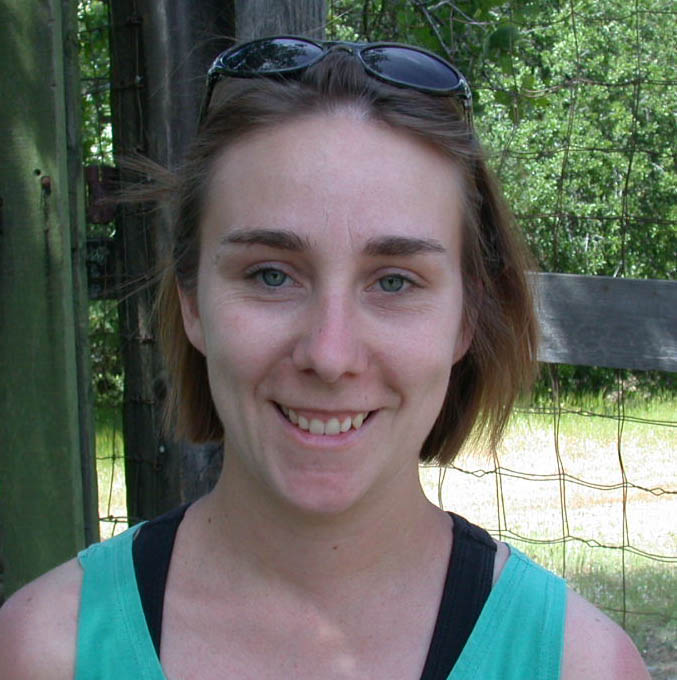 |
Susan L. Perkins, PhD Assistant Curator Division of Invertebrate Zoology American Museum of Natural History Central Park West at 79th Street New York, NY 10032 e-mail Susan http://research.amnh.org/users/perkins/ |
|
Susan received her undergraduate degree from the State University of New York, and then devoted a few years to the study of bat ecology and behavior with field work in Trinidad. She subsequently developed an interest in parasites, and came to the lab to pursue the Ph.D., finishing in 2002. Susan studied the diversity of malaria parasites, and published the largest phylogeny of those organisms, including species from all the continents and from a broad range of vertebrate hosts. That paper is now one of the top cited for the Journal of Parasitology. (Later, Susan collaborated with our Ellen Martinsen on an even larger, more detailed, phylogeny that is now the gold standard for the systematics of malaria parasites.) During her grad research, Susan also found a cryptic species of lizard malaria parasite, the first such finding using molecular data. Susan tracked the evolutionary history of three species of Plasmodium from Anolis lizards throughout the eastern Caribbean, and took 11 field trips to the islands over a three year period. Susan was awarded an NSF predoctoral fellowship from the University of Vermont training grant, and then a NSF postdoctoral fellowship in bioinformatics. After several years as an Assistant Professor at the University of Colorado, she accepted a position at the American Museum of Natural History where she has received tenure and is a permanent member of the professional staff at that great institution. Susan's publications include the work on malaria parasites as well as the bacterial symbionts of leeches, and systematics of bats. She now serves as an editor for Journal of Parasitology. Susan also is heavily involved in teaching and exhibits at the Museum, and most recently co-curated a spectacular display on the organisms that live in and on the human body -- receiving lots of great notice in the media.
Her publications on malaria parasites are included in the publications section of this site. |
|
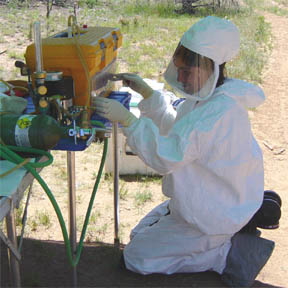 |
Rebecca Eisen, PhD Division of Vector-Borne Infectious Diseases Centers for Disease Control and Prevention PO Box 2087 Fort Collins, CO 80522 e-mail Becky |
|
Becky Eisen received her BS degree from the University of Michigan in 1995, and then joined the lab to complete the Ph.D. in 2000. She developed an interest in parasites while an undergraduate student and during summers at the University of Michigan field station. For her Ph.D. project Becky studied the life history traits of Plasmodium mexicanum, both in experimental infections and in a massive mark-recapture project that lasted four seasons. This was the longest and largest mark-recapture study of any malaria parasite of wildlife. Becky sought training in GPS techniques and put the skills to use in a study of the fine-scale patterns in prevalence of Plasmodium mexicanum in the fence lizards at Hopland. After graduate school, Becky joined the laboratory of Robert Lane as a postdoctoral fellow at UC-Berkeley. There she studied the ecology, transmission biology, and distribution of Lyme Disease in both tick vectors and various wildlife species. She is now at the CDS working with a variety of pathogens and their ecology. A recent study saw Becky tracking down the source of a tragic lethal infection with plague in a wildlife biologist working in the Grand Canyon She followed the path of the biologist and found the very spot where he most likely became infected by handling a dead mountain lion that had been infected. Becky showed that the bacteria causing plague can live in the soil for a surprisingly long time. Becky has published over 100 papers in major journals such as Proceedings of the Royal Society, Journal of Parasitology, and Parasitology.
Her publications on malaria parasites are included in the publications section of this site. |
|
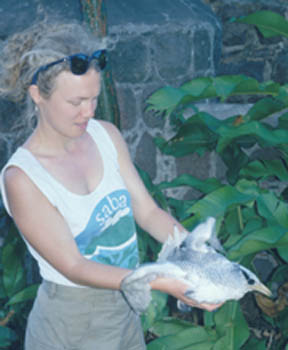 |
Christine Staats, MS, MD |
| Christine Staats began her undergraduate years at the University of Massachusetts, transferring to complete her degree in Biology at the University of Vermont. As an undergraduate she was a work-study student in the malaria lab, and was a Research Assistant at the Hopland site for a summer. After graduation Chris worked as a technician in a bat physiology laboratory at UC-Berkeley and then in the Medical School here in Vermont. She returned to UVM to pursue the MS in the lab. Chris did her MS research in the Caribbean islands, living on Saba, Netherlands Antilles, for several months to complete a detailed study of the virulence of three species of Plasmodium infecting the endemic Saban anole. She traveled throughout the eastern Caribbean islands to study the biogeography of lizard malaria, and to conduct an among-species test of the Hamilton-Zuk hypothesis. This was a very productive MS project, leading to fully five publications in journals such as Oecologia and Biotropica. After receiving her MS, Chris entered medical school and is now a physician in family practice in Vermont, and is one of the most respected physicians in Burlington. Chis lives in Burlington with her husband, Brian Perkins a well-known musician, and daughter Ella who is already a respected writer. | |
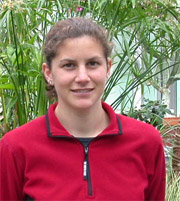 |
Sarah M. Osgood, MS |
| Sarah first was an undergraduate work-study student in the malaria lab, and completed her senior research project in collaboration with graduate student Susan Perkins. She worked up a nested PCR method to detect very weak infections of Plasmodium mexicanum in fence lizards, then compared the prevalence of subpatent (under the microscope) infections at sites with high and low overall prevalence. The research suggested a life history strategy of the parasite to remain at low parasitemia at sites with infrequent transmission. The work resulted in a frequently-cited paper in Molecular Ecology. During that busy time, Sarah spent two summers at the Hopland site, as a field assistant for graduate student Becky Eisen. Sarah then worked in a research laboratory in biochemistry where she learned a broad array of techniques, and also met her future husband. She returned to the malaria lab to pursue the MS degree. Her graduate project examined the influence of clonal diversity on the sex ratio of Plasmodium mexicanum, working both at the Hopland site and the UVM laboratory. Her thesis resulted in three publications in the journals Parasitology and Journal of Parasitology. She is now performs the amazing task of balancing a position in a research lab with being the mother of two small children. | |
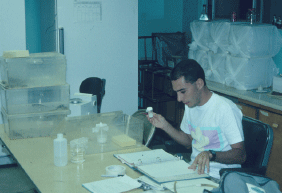 |
Roberto Fialho, MS, PhD |
| Roberto Fialho received his undergraduate education at the State University of Rio de Janeiro, perhaps the finest university in Brazil. His undergraduate research thesis centered on the feeding biology of a small frog. He found that the frog eats only the fruit of the dominant shrug in the habitat (a fruit-eating frog!), but spends the nights in the water pool within a large terrestrial bromeliad. The frog defecates the fruits seeds in the only place in the environment where the seeds will find enough moisture to germinate. The shrub grows and eventually kills the bromeliad. Thus, the entire structure of the habitat depends on the frog behavior. This work resulted in two publications. Rob then came to the malaria lab. His MS project examined the influence of temperature on the rate of development of Plasmodium mexicanum in its insect vector (a sandfly). He found that the parasite manipulates the insect to choose a warmer location, thus allowing the parasite to complete development before the sandfly takes its next blood meal. This work was done at the Hopland site, and resulted in a publication in the Journal of Animal Ecology which received considerable attention. Roberto then pursued the Ph.D. in ecological genetics with Dr. Lori Stevens in our department. He looked at the influence of Wolbachia symbionts on the biology of beetle hosts. Rob bravely fought cancer throughout his graduate career, and his Ph.D. work was published after his death in 2000 in several journals including the Proceedings of the Royal Society of London. Rob received his Ph.D.posthumously in 2002. Rob gave the lab his three-part motto, that rules whenever things get tough: "Never give up, never give up, never give up." Dr. Michael Upton MD, a highly respected physician in Vermont, has established a fund to honor Rob by awarding a grant each year to an outstanding graduate student. | |
 |
Denise Dearing, MS, PhD Associate Professor Department of Biology University of Utah Salt Lake City, Utah 84112 e-mail Denise http://www.biology.utah.edu/faculty2.php?inum=25 |
| Denise received her MS from the University of Vermont, then went on for the PhD at the University of Utah. While in the UVM laboratory, she pursued two very different projects. First, she examined the impact of infection with Plasmodium mexicanum on male-male competition for mates of the fence lizard host. This was published in Oecologia before Denise even began her "real" graduate project. She then spent over a year on the Caribbean island of Bonaire, examining the diet choice of the herbivorous lizard, Cnemidophorus murinus. The project resulted in four publications, including a major work in Ecology. Her PhD studies on diet selection in the Pika are a classic, and led to her receiving highest honors from the Ecological Society of America and several prestigious postdoctoral fellowships. After extensive field work in Australia and Tasmania, Denise had to return to the real world and accepted a position back at the University of Utah. She now divides her time between projects on diet of herbivores and (finally returning to the really interesting problems!) the parasite-host ecology of Hanta virus and rodent hosts. Her recent publications have been in major journals such as Chemical Ecology and Emerging Infectious Diseases To learn more about the Dearing lab projects, visit her web site, address above. | |
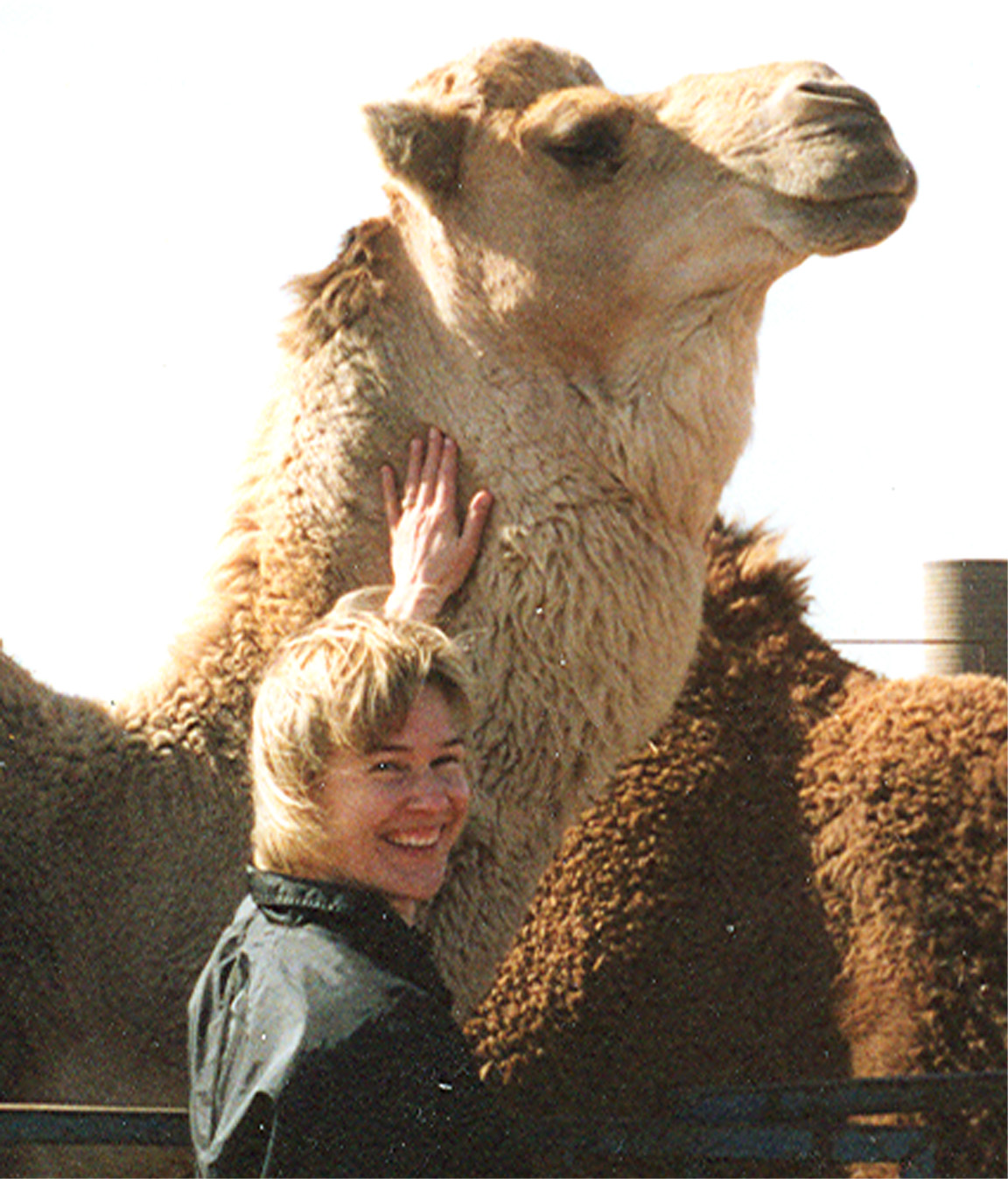 |
Diane Faile, MS http://www.mindlikewater.com |
| Throughout her life, Diane Faile has had very broad interests, including literature, writing, gardening, and nature. As an example of that eclectic style, Diane received degrees in Biology and English from Bowdoin College, a distinguished liberal arts college in Maine. She came to the malaria lab, but revealing a strong independent streak, chose a research project in animal behavior, and organized a team of volunteers to assist in a massive study of nesting behavior of the pelagic cormorant, a seabird that nests on cliff faces on the Pacific coast of California. The study, the largest ever done on that species, is now referenced in standard reviews in ornithology. Diane then went on to receive a degree in environmental law from the University of Oregon, and worked for some years in that field. In recent years she has returned to her interest in literature, becoming an partner in an e-publishing firm, Mind Like Water, often serving as an editor and mentor for writers. | |
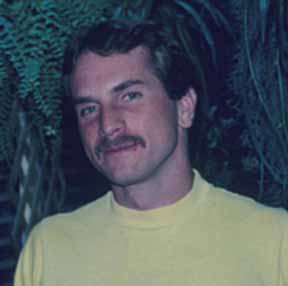 |
Steve Ressel, MS, PhD College of the Atlantic 105 Eden Street Bar Harbor, Maine 04609 |
| After receiving his undergraduate education in Biology from Millersville University in Pennsylvania, Steve was a research technician for several years at the Penn State Medical School, then came to the malaria lab for his MS program. Steve has broad interests in life science, and so conducted field work on the diet selection of a herbivorous lizard on Aruba island (resulting in a publication in Copeia), then additional field work to identify lizard malaria parasites in the lizards of Costa Rica. Steve was interested in how parasites influence the sexual selection for their hosts, and was honored to discuss these issues with W. D. Hamilton when Bill visited our department. This meeting occurred just before the Hamilton-Zuk hypothesis was published in Science, and led Steve to test the hypothesis with a study of the sexually dimorphic color of fence lizards at Hopland infected with Plasmodium mexicanum. This early work on the H-Z hypothesis resulted in a paper in Oecologia. Steve then went on for the PhD degree at the University of Connecticut, again switching gears to study the biophysics of frog calling, with much field work in Central America. He is now a Professor at the College of the Atlantic on the coast of Maine where his office looks out over the Atlantic Ocean! Note his mailing address is on Eden Street. | |
 |
Carl Bromwich, MS, MD Kuujjuag, Canada |
| Carl Bromwich studied as an undergraduate at Franklin and Marshall College, was the first graduate student in the malaria lab. His MS project was a two year mark-recapture study at the Hopland site, the most detailed look at the dynamics of natural infection of any malaria parasite of nonhumans. These results were published in Ecology. He then spent six months in Sierra Leone in west Africa to study the virulence and prevalence of two species of Plasmodium in Agama lizards. Several more publications emerged from this study. Carl then received his MD degree from the Dartmouth Medical School and for some years has been a physician in the Canadian Arctic, 1000 miles north of Montreal. Because local cuisine often includes aged meat from marine mammals, botulism is a hazard. Carl has successfully treated more people suffering from botulism poisoning than any other physician. | |